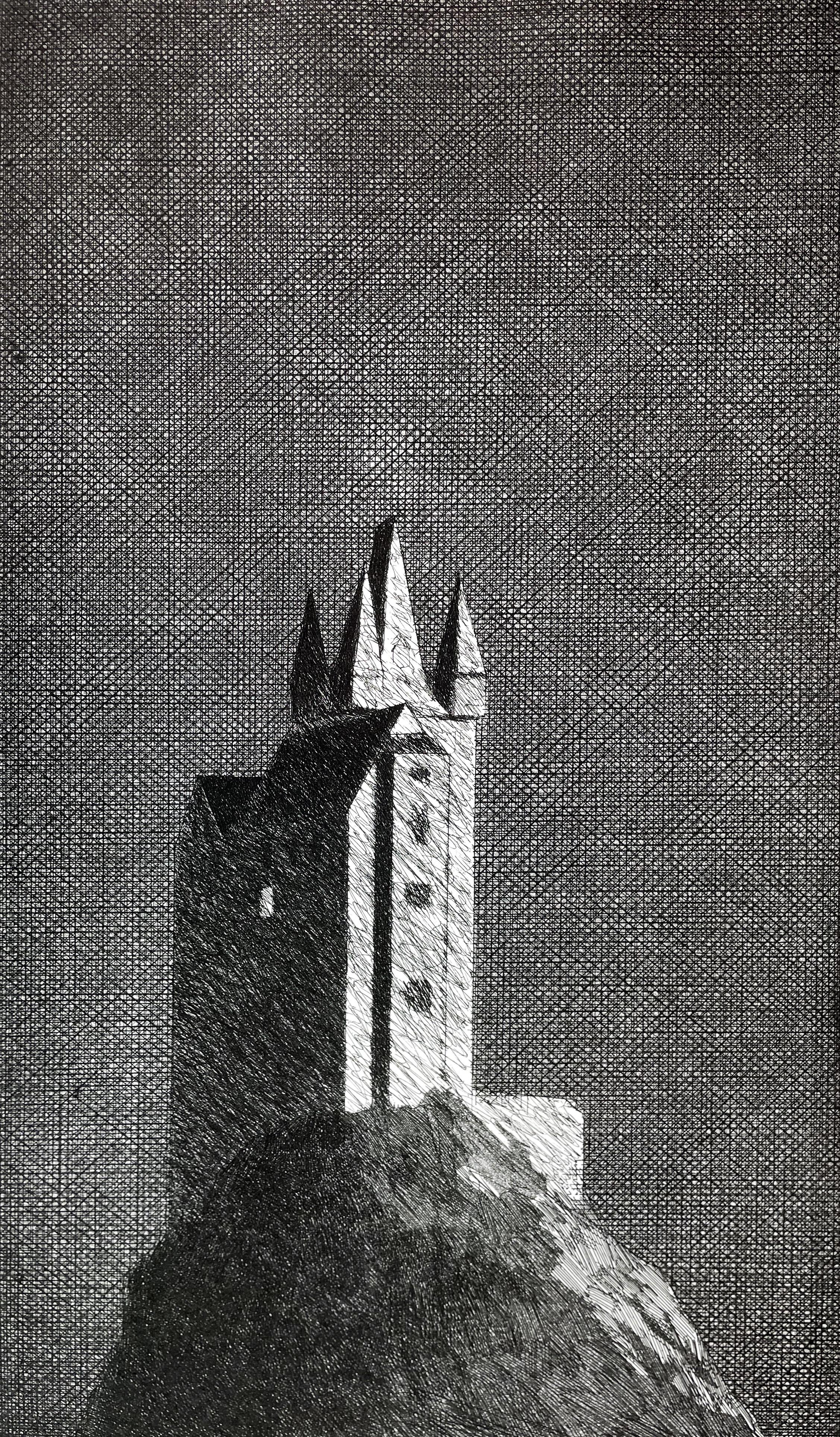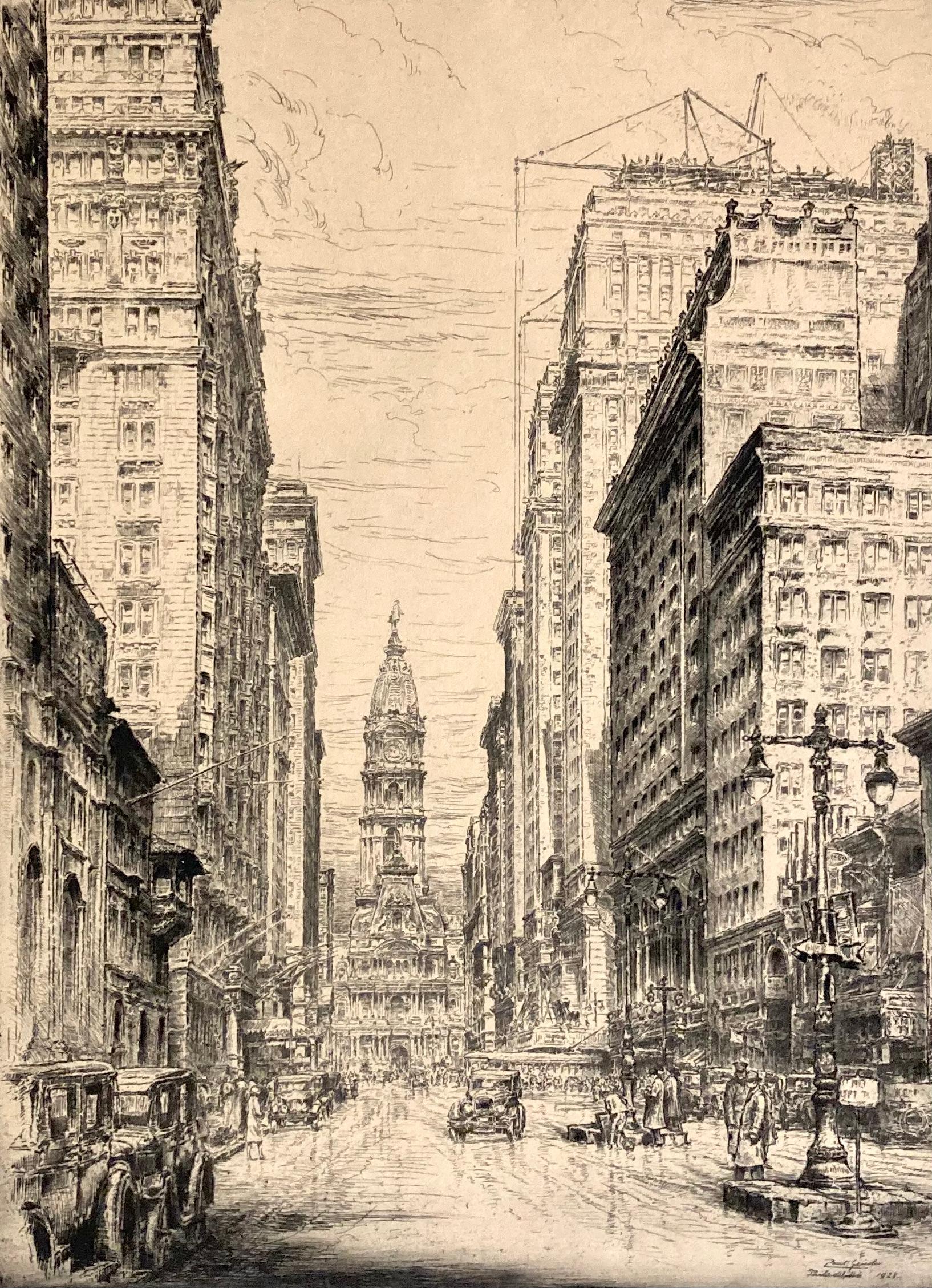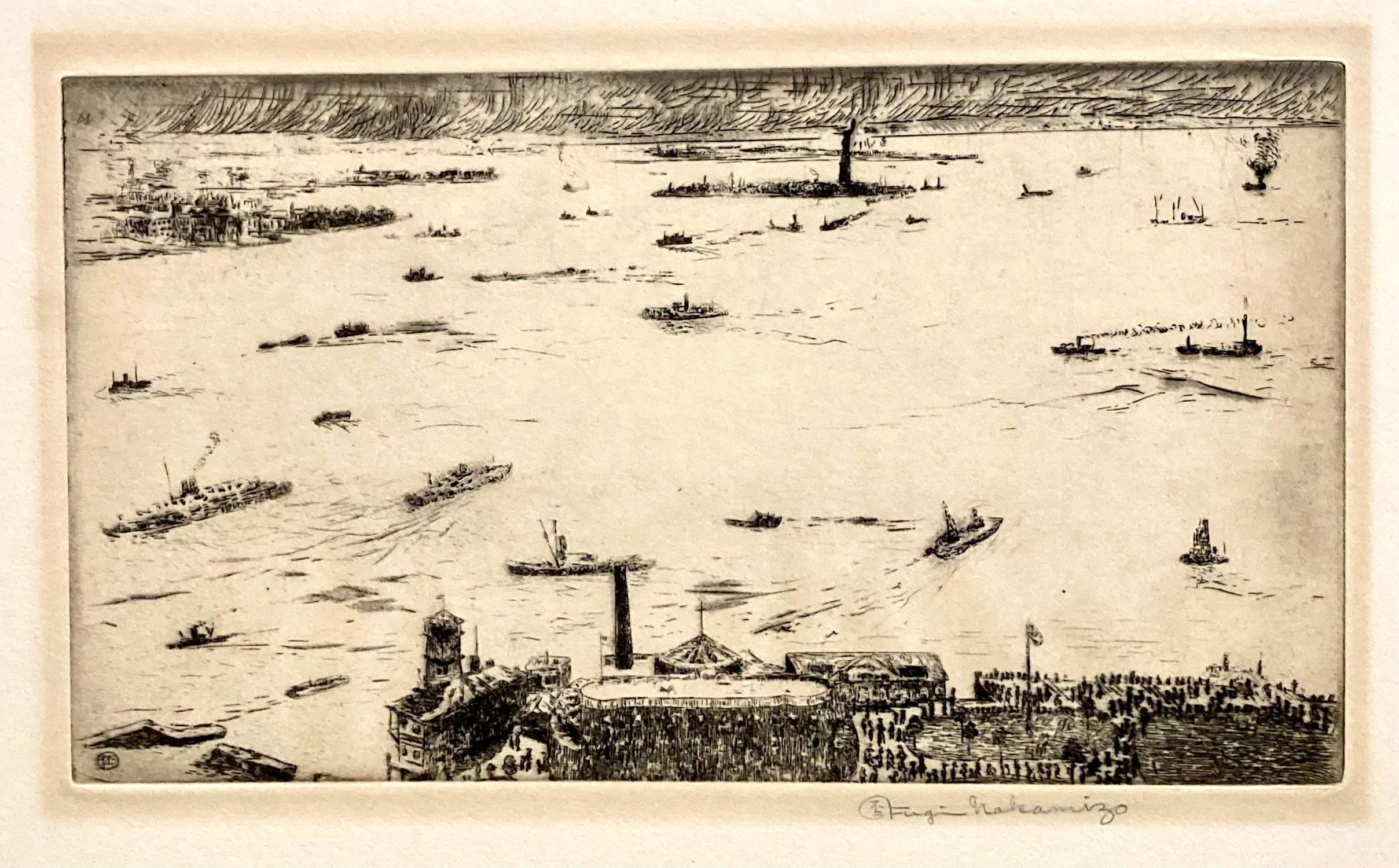Items Similar to Maurice de Vlaminck - Original Handsigned Etching
Want more images or videos?
Request additional images or videos from the seller
1 of 11
Maurice de VlaminckMaurice de Vlaminck - Original Handsigned Etching1924
1924
About the Item
Maurice de Vlaminck - Original Handsigned Etching
Title: L'Oise à Cergy
Reference: Catalogue raisonné Walterskirchen, n°110.
Original etching, hand-signed in pencil by the artist ; also signed in the plate at the bottom left corner of the image.
Dimensions: Paper sizes: 32,7 x 50,9 cm ; image sizes: 23,5 x 32 cm.
Support: Hollande paper.
1924
Maurice de Vlaminck
Maurice de Vlaminck (1876-1958) was born in Paris, in 1876, and was born in to a family of famous musicians. He learned to play violin, and was taught by his father in his late teens. He turned his attention to art, in 1893, when he began to study under Henri Rigalon. In 1984 Vlaminck married Suzanne Berly. He served in the army, and during the end of his career, met André Derain, on a train ride home, in 1984, which is where his artistic lifestyle, and his illustrious career as an artist took a turn. Although he served in the army until the end of 1900, he immediately opened a small art studio with Derain, the famous artist he had become friends with on his train ride years prior.
Artworks
Some of Maurice de Vlaminck’s most famous works include Sur le zinc (1900) Le’homme a la pipa (1900), La Siene a Chatou, Le Pont de Chatou, Toulouse Lautrec, and several landscape paintings and paintings of homes which were inspired by Chatou (which he lived in for the years following 1900 when he opened the studio).
Art Style
Seine-ChatouMost of Maurice de Vlaminck’s work was considered to be work that was developed during the Fauve movement. He, along with Derain, and Matisse were considered the principle figures in the start of this movement with their revolutionary works. This style of painting, which was formed by the modern artists, is known for use of bright and intense colors in the works they depicted.
In many of his earlier pieces, the artist seemed to lack attention to detail. He would not pay attention to detail, and he would instead use the bright colors and thicker brush strokes to create landscapes that depicted his emotions and the way he was feeling, as opposed to actually putting in much effort to create detailed design styles in the works he created for the majority of his earlier career in art.
Influences
Much of Vlaminck’s works were similar to those works known as Impressionist art works. Van Gogh was one of his influences, and after taking a visit to a museum, Vlaminck fell in love with the artist’s style and take on art. Later on in his career, many of his art works become more monochromatic, and a major influence that he followed was Cezzane.
Later art works
In the later portion of his career, Vlaminck diverted from the bright colors and the style which he had developed early on in his career. Much of his work began to draw on a darker palette and color choices. This was contrasted by heavy white strokes of paint on the canvas, to give his work a distinct and unique design theme.
The French Fauvist painter drew from several influences, and was one of the founders of the Fauve movement which he became so famous for. Although his later works strayed, and took a unique turn, many art enthusiasts love the painter’s unique creations, and his use of thick brushstrokes and unique color blends in paintings.
- Creator:Maurice de Vlaminck (1876-1958, French)
- Creation Year:1924
- Dimensions:Height: 12.88 in (32.7 cm)Width: 20.04 in (50.9 cm)
- Medium:
- Movement & Style:
- Period:
- Condition:
- Gallery Location:Collonge Bellerive, Geneve, CH
- Reference Number:1stDibs: LU16122113403
About the Seller
4.9
Gold Seller
These expertly vetted sellers are highly rated and consistently exceed customer expectations.
Established in 2015
1stDibs seller since 2015
908 sales on 1stDibs
Typical response time: 1 hour
- ShippingRetrieving quote...Ships From: Collonge Bellerive, Geneve, Switzerland
- Return PolicyA return for this item may be initiated within 7 days of delivery.
More From This SellerView All
- Dufza - Paris - Montmartre - Original Handsigned EtchingLocated in Collonge Bellerive, Geneve, CHDufza - Paris - Montmartre - Original Handsigned Etching Circa 1940 Handsigned in pencil Dimensions: 20 x 25 cmCategory
1940s Modern Landscape Prints
MaterialsEtching
- Dufza - Paris - Le Vert Galant - Original Handsigned EtchingLocated in Collonge Bellerive, Geneve, CHDufza - Paris - Le Vert Galant - Original Handsigned Etching Circa 1940 Handsigned in pencil Dimensions: 20 x 25 cmCategory
1940s Modern Landscape Prints
MaterialsEtching
- Dufza - Paris - Saint Michel - Original Handsigned EtchingLocated in Collonge Bellerive, Geneve, CHDufza - Paris - Saint Michel - Original Handsigned Etching Circa 1940 Handsigned in pencil Dimensions: 20 x 25 cm Unumbered as issuedCategory
1940s Modern Landscape Prints
MaterialsEtching
- Dufza - Paris - Le Pont Neuf - Original Handsigned EtchingLocated in Collonge Bellerive, Geneve, CHDufza - Paris - Le Pont Neuf - Original Handsigned Etching Circa 1940 Handsigned in pencil Dimensions: 20 x 25 cm Unumbered as issuedCategory
1940s Modern Landscape Prints
MaterialsEtching
- Dufza - Paris - Champs Elysées - Original Handsigned EtchingLocated in Collonge Bellerive, Geneve, CHDufza - Paris - Champs Elysées - Original Handsigned Etching Circa 1940 Handsigned in pencil Dimensions: 20 x 25 cm Unumbered as issuedCategory
1940s Modern Landscape Prints
MaterialsEtching
- Dufza - Paris - Conciergerie - Original Handsigned EtchingLocated in Collonge Bellerive, Geneve, CHDufza - Paris - Conciergerie - Original Handsigned Etching Circa 1940 Handsigned in pencil Dimensions: 20 x 25 cmCategory
1940s Modern Landscape Prints
MaterialsEtching
You May Also Like
- The Haunted Castle (Six Fairy Tales from the Brothers Grimm) David HockneyBy David HockneyLocated in New York, NYThe Haunted Castle (from Six Fairy Tales from the Brothers Grimm) Etching and aquatint on W S Hodgkinson paper watermarked "DH" and "PP" Paper 17.5 x 12.25 in. / 45 x 31 cm Plate 14 ...Category
1960s Modern Figurative Prints
MaterialsEtching
- Rapunzel, Rapunzel let down your Hair (Six Fairy Tales from the Brothers Grimm)By David HockneyLocated in New York, NYSheet from “Rapunzel” story (from Six Fairy Tales from the Brothers Grimm) Text printed letterpress and “Rapunzel, Rapunzel let down your Hair” etching and aquatint on W S Hodgkinson paper watermarked "DH" and "PP" Etching 10.5 × 9.85 in. / 26.7 × 25 cm Paper 17.5 x 12.25 in. / 45 x 31 cm Unsigned: apart from the published edition of 400 books and 100 portfolios. This is one of eleven images recently found in our archive which we have decided to make available. There is one only of each image. Perhaps the most famous story from the Grimm Brothers, Rapunzel spins the tale of a beautiful young princess locked away by an evil sorceress. Captured in this scene is the moment a King's son came across the tower and fell in love with her sweet singing, beseeching her: 'Rapunzel, Rapunzel, Let down your hair to me.' Though the sorcerer banishes Rapunzel and maims the prince, they are of course ultimately reunited to live happily together. Hockney illustrates this scene with incredible texture detail: layers of aquatint defining the soft forest floor, delicate hatching on the horse's haunch, the tower's tight crosshatching, and of course the lyrical gesture of Rapunzel's hair which cascades from the upper right corner. This print from our publisher's archives is one of thirty-nine etchings from David Hockney’s 1969 "Six Fairy Tales from the Brothers Grimm". Hockney worked on this series with Paul Cornwall-Jones at Petersburg Press over the course of a year. 400 books and 100 portfolios plus artist’s proofs were printed. The artist illustrated six stories: 'The Little Sea Hare', 'Fundevogel', 'Rapunzel', 'The Boy who left Home to learn Fear', 'Old Rinkrank' and 'Rumpelstilzchen'. According to Hockney, "They're fascinating, the little stories, told in a very, very simple, direct, straightforward language and style, it was this simplicity that attracted me. They cover quite a strange range of experience, from the magical to the moral." He was inspired by earlier illustrators of the tales, including Arthur Rackham and Edmund Dulac, but Hockney reimagined the stories for a modern audience. The frontispiece for the project pictures Catherina Dorothea Viehmann, the elderly German woman who recounted fairy tales to the Grimm brothers when they were in their late twenties. In Hockney's words: “The stories weren’t written by the Brothers Grimm…they came across this woman called Catherina Dorothea Viehmann, who told 20 stories to them in this simple language, and they were so moved by them that they wrote them down word for word as she spoke.” Hockney drew the German woman in the style of Dürer, formally posed yet naturalistic against an impeccably crosshatched swath of grey. Hockney wrote about the surreal plots contained in the Brothers Grimm tales: “…the stories really are quite mad, when you think of it, and quite strange. In modern times, it’s like the story of a couple moving into a house, and in the next door’s garden they see this lettuce growing: and the wife develops this craving for the lettuce that she just must have and climbs over to pinch it, and the old woman who lives in the house next door says well, you can have the lettuce if you give me your child, and they agree to it. And if you put it into terms like this and imagine them in their semi-detached house agreeing to it all, it seems incredible.” Hockney enhanced this unbelievable quality with his illustrations which traverse inky, dense areas of intense crosshatching and minimalist line work. Rather than serving as direct interpretations of the plot, the images capture moments and feelings. Some portray the magic yet mundane -- Rapunzel's tiny face gazing placidly at a well-tended garden, or project danger and unease as in The Haunted Castle, with its citadel perched atop craggy rocks, dramatically lit against a dark sky. Hockney's sense of humor comes through in Cold Water About to Hit the Prince, in which a man tucked into bed stares straight at a rush of water drawn with a splash (this technique is likely Spit Bite, and the resultant bold spattered brushstroke contrasts beautifully with the rest of the carefully crosshatched image). A Wooded Landscape, with its lush textures, conveys the bucolic setting of a fairy tale and the potential danger hidden within the woods -- the viewer is left to wonder who lives on the hilltop in that diminutive cabin. These etchings defy the conventions of beautiful fairy tale illustrations...Category
1960s Modern Landscape Prints
MaterialsEtching, Aquatint
- Paul Geissler, PhiladelphiaLocated in New York, NYPaul Geissler's view of downtown Philadelphia features it's wonderful city hall. Philadelphia is gifted with an actual plan and the city hall itself is a...Category
Early 20th Century American Modern Landscape Prints
MaterialsEtching
- Luigi Lucioni, (New England Barn)By Luigi LucioniLocated in New York, NYPainter and printmaker, Luigi Lucioni was known for his portraits, still life paintings, and landscapes of Vermont and Italy. This 'New England Barn' ...Category
Mid-20th Century American Modern Figurative Prints
MaterialsEtching
- Kent Hagerman, (US Air Force Fairchild C-119, the 'Flying Boxcar')By Kent HagermanLocated in New York, NYWhile this is probably a military airport, Kent Hagerman still shows it at its futuristic best. Hagerman was an amazing draftsman who managed to get fantastic detail into his work. This is really a portrait of a plane -- the Fairchild C-119. The words 'United States Air Force' on the side of the plane date it to 1947 or later, after the Air Force split from the Army. The design featured the 'twin boom' clearly showing in this etching. Thanks to this feature it was called the Flying Boxcar. About 1100 were built and used until 1955. It was also used by the Chinese Air...Category
Mid-20th Century American Modern Figurative Prints
MaterialsEtching
- Fugi Nakamizo, New York Harbor from the BatteryLocated in New York, NYJapanese born, Fugi Nakamizo came to New York City in 1910. He studied at the Art Students League and Cooper Union, NYC, and also printmaking with Joseph Pennell. He worked on the Federal Public Works of Art Project in the 1930s and in the 40s, during WWII, was interned at the Japanese-American internment camp in Topaz, Utah. His work is in the permanent collections of the Metropolitan Museum of Art and the Brooklyn Museum of Art, NYC, and the Library of Congress and Smithsonian Institution, Washington, DC. This etching of New York...Category
1920s American Modern Figurative Prints
MaterialsEtching
Recently Viewed
View AllMore Ways To Browse
Small Etchings Modern
Famous Musicians
Small French Etching
Small Original Signed Etchings
Early Painted Landscape Plates
Maurice Andre
Van Gogh Original
French Etching 1900
Lautrec Original
Toulouse Lautrec Original
Matisse Etchings
Vlaminck Maurice
Les Hommes
Toulouse Lautrec Original Print
Violin Print
Henri Matisse Etching
Etching Musician
Henri Matisse Original Hand Signed



